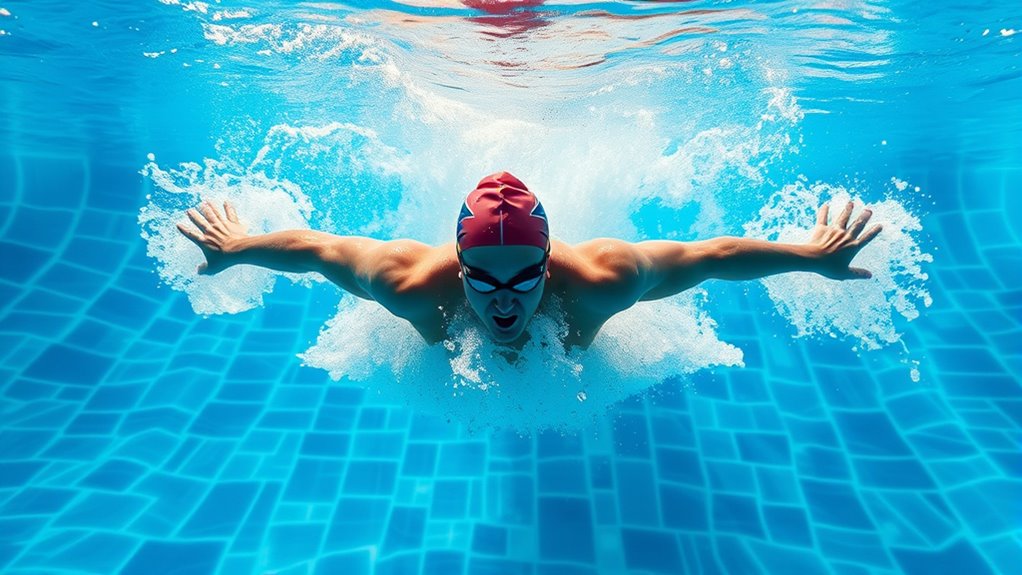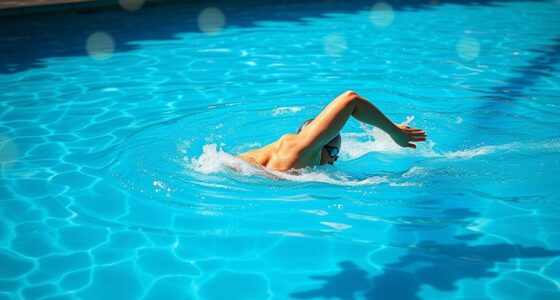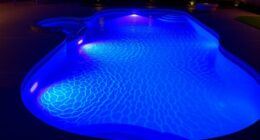To build endurance with pool interval training, start with manageable sets like 30 seconds of fast swimming followed by 30 seconds of rest. Focus on efficient techniques for each stroke to conserve energy and prevent fatigue. Gradually increase effort duration and intensity as your stamina improves, incorporating various strokes for variety. Always warm up, stay hydrated, and listen to your body’s signals. Keep practicing consistently, and you’ll discover even more tips for maximizing your workouts.
Key Takeaways
- Start with manageable intervals, like 30 seconds fast swimming followed by 30 seconds rest, and gradually increase intensity.
- Focus on proper technique and streamlined body position to conserve energy and enhance endurance.
- Incorporate a variety of strokes such as breaststroke, freestyle, and backstroke to prevent boredom and develop balanced stamina.
- Maintain consistent workout schedules with appropriate rest days to support muscle recovery and performance gains.
- Prioritize pool safety by warming up, staying hydrated, and being aware of surroundings during high-intensity interval sessions.

Interval training workouts in the pool are an effective way to boost your cardiovascular fitness and build strength without putting stress on your joints. When you incorporate interval training into your routine, you push your body through high-intensity efforts followed by recovery periods, leading to improved endurance over time. This approach is especially beneficial if you’re recovering from injuries or want a low-impact workout that still challenges your body. To maximize your gains, focus on mastering efficient breaststroke techniques, which allow you to conserve energy while maintaining speed. Proper form is essential; keep your movements smooth, streamline your body, and avoid unnecessary resistance. This not only helps in building endurance but also reduces the risk of fatigue and injury.
As you start your interval training, pay close attention to pool safety tips. Always warm up before diving into high-intensity efforts to prepare your muscles and prevent cramps. Keep hydrated, as pool workouts can be deceptively exhausting, and dehydration can impair your performance and recovery. Use goggles to protect your eyes, and consider wearing a swim cap to reduce water resistance and improve your overall efficiency in the water. It’s crucial to be aware of your surroundings—know where the pool edges, ladders, and other swimmers are to avoid accidents. If you’re new to interval training, begin with shorter, manageable intervals, such as 30 seconds of fast swimming followed by 30 seconds of rest, and gradually increase the intensity and duration as your endurance improves. Incorporating proper training techniques can further enhance your workout effectiveness and safety.
Incorporate different strokes into your training to prevent boredom and develop a well-rounded endurance base. While breaststroke is excellent for building strength and technique, mixing in freestyle or backstroke can improve your overall stamina and keep your workouts engaging. Remember that consistency is key: stick to a regular schedule and listen to your body. If you feel overly fatigued or notice discomfort, take a break or reduce the intensity. Rest days are just as important as workout days—they allow your muscles to recover and adapt, leading to better performance over time.
Frequently Asked Questions
How Often Should I Incorporate Interval Training Into My Swimming Routine?
You should incorporate interval training into your swimming routine about 2 to 3 times a week. This training frequency allows you to improve endurance without overtraining. Mixing in interval sessions adds workout variety, helping you stay motivated and avoid plateaus. Be sure to listen to your body, and gradually increase intensity to prevent injury. Consistency and variety are key to building endurance effectively through interval training.
Can Beginners Safely Do Interval Workouts in the Pool?
Imagine gently riding the waves, feeling confident with every stroke—that’s what safe swimming looks like. As a beginner, you can absolutely do interval workouts, but focus on mastering proper swimming techniques and water safety first. Start slow, listen to your body, and gradually increase intensity. With proper guidance and patience, you’ll build endurance safely, turning each swim into a confident, enjoyable experience.
What Equipment Is Necessary for Effective Pool Interval Training?
For effective pool interval training, you mainly need a good swimsuit selection that allows free movement and comfort. Waterproof timers are essential to track your intervals accurately without worry. You might also consider goggles for clear visibility and a kickboard for specific drills. These tools help you stay focused and organized, ensuring your workout is efficient and safe. With the right equipment, you can improve your endurance and enjoy your swim sessions more.
How Do I Prevent Injuries During High-Intensity Swimming Intervals?
Think of your body as a finely tuned engine—you want to keep it running smoothly. To prevent injuries during high-intensity swimming intervals, always start with a proper warm-up to loosen muscles and improve blood flow. Focus on technique correction to avoid strain and confirm efficient movement. Listen to your body, and don’t push through pain. These steps help you stay safe and maximize your workout’s benefits.
What Are Some Common Mistakes to Avoid in Pool Interval Training?
When doing pool interval training, avoid common mistakes like poor pacing and breathing errors. You might push too hard or go too slow, which hampers progress and increases injury risk. Focus on maintaining a steady rhythm and controlled breathing to stay consistent. Don’t forget to listen to your body; rushing can lead to fatigue or strain. Proper pacing and breathing help you maximize performance while keeping safe.
Conclusion
So, there you have it—dive into interval training and pretend you’re training for the Olympics, even if you’re just trying to survive the next family pool day. Push yourself, rest a bit, then push again, all while secretly wondering why you’re voluntarily torturing yourself. But hey, at least you’ll be “building endurance,” right? Who knew that swimming laps could double as a comedy of errors and a workout? Embrace the chaos—you might just surprise yourself.









